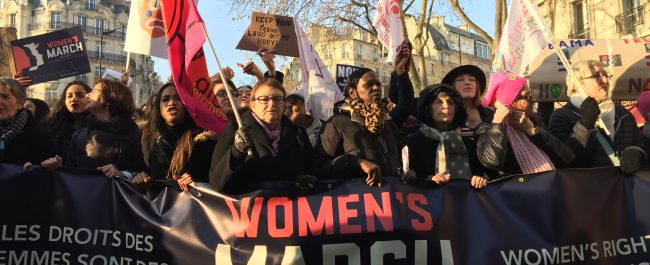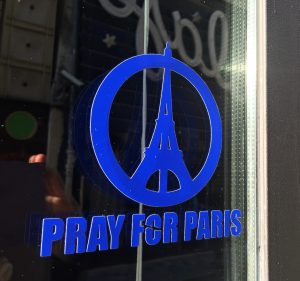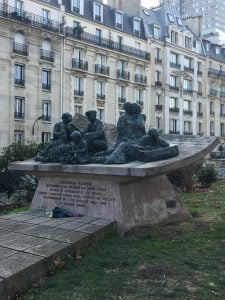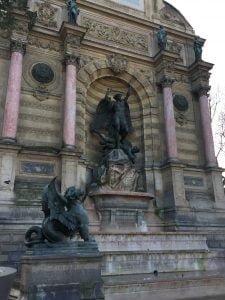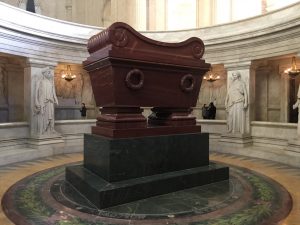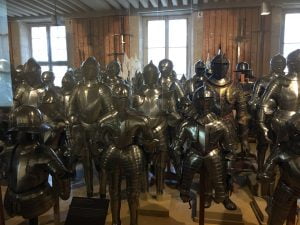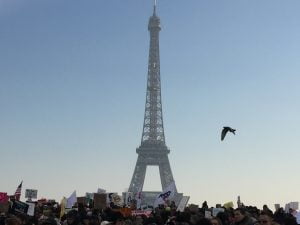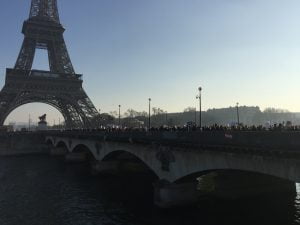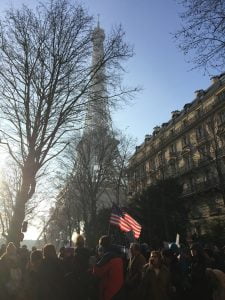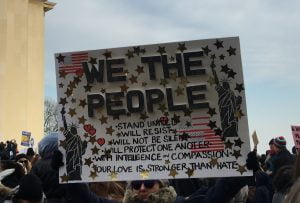Paris 19 – 23 January 2017 : Inauguration of the 45th President of the United States
I hadn’t intended to march.
In the weeks leading to Trump’s inauguration day I’d asked myself repeatedly how to mark a moment. A moment in time. A moment in history. A moment when before becomes after. A moment to be afraid, angry, excited, confused, empowered. Do you throw yourself into such a moment? Run and hide from it? Or simply stay still and watch?
I hadn’t intended to march. I’d intended to be alone.
Months before the news of the US election result hit the world hard, a friend sent me a link to the Wikipedia page for the Vel’ d’Hiv Roundup – the mass arrest of Jews in Paris by the French police on 16 and 17 July 1942. A moment in history named after the Velodrome d’Hiver where the Jews were held after being rounded up, before being carted off to Auschwitz, most never to see the streets of Paris, or anywhere else, again. When I heard the news I recalled the email and decided to make a small, simple, peaceful, solitary gesture to history on inauguration day at the memorial for the 13,000 Jews, including over 4,000 children, who were rounded up because of the beliefs they put their faith in. I wanted nothing to do with mass protests or marches, preferring time alone to reflect, lay flowers on the past, come to terms with the present and make plans for a better future.
I hadn’t indented to march. I intended to walk.
On the morning of Friday 20 January 2017 I left my hotel in the 14th arrondissement and set off on foot for the memorial, walking aimlessly at first, getting lost numerous times. Well meaning Parisians tried to help, but still I ended up taking the long way round through St Germain, the stomping ground of preference for Satre, Simone de Beauvoir and Picasso, until eventfully I found my bearings and turned west towards the Eiffel Tower – looking like a painted stage set against a hazy ice blue winter sky. I was aiming for an unassuming park, steps away from the Tower and Bik-Hakeim metro station. A thin strip of landscaped concrete on the Quai de Grenelle, sandwiched between the busy main road and the Seine.
After two hours of walking I found the park and paused to draw a cold breath in a sub zero Paris before taking in the memorial and the moment. It was smaller than I expected, positioned at the far end of the park away from the Eiffel Tower and overlooked by many buildings yet to be built when those it’s dedicated to were alive. I perched on a cold stone ledge and contemplated the line of rigid lamp posts and bare winter trees that drew all eyes to a collection of small, life like statues arranged on a curve of stone recreating a strip of the long demolished cycling track of the Velodrome d’Hiver. Despite negative temperatures, the low winter sun warmed my face and shone onto the tip of my pencil as I took down notes – adding a halo to blunt lead, blank page and my thoughts.
Noises of the busy main street – car horns, mopeds, police sirens – flooded in from one side, a jogger ran past on the other and a cold breeze rustled through bare branches and plastic rubbish bags. Underneath it all, the silence of the Seine and the smell of a city used to moments in time. The chill of the stone ledge seeped inside me and eventually I stood to walk the short distance to the memorial, too cold to contemplate any more.
I hadn’t intended to march. I intended to be still.
The statues – a pregnant woman, an old man, children – are small, but the emotion carved into them is vast. I think of the moment their lives changed and try to understand how it happened and face inside of me the part of us that allows, stays silent and is sometimes complicit. I’m overwhelmed with a sadness that takes me by surprise. The horror, confusion, terror and fear of the past suddenly seem real, immediate and of the moment. I stoop to lay a bouquet of nine white roses at the base of the statue. Roses bought in a supermarket in the shadow of both UNESCO and the European Space Agency. I send love to the past that UNESCO protects and the desire to experience new horizons that propels us into space. I think of a man waiting to place his hands on two bibles held by his wife and make a promise to a country and the world. A man who invests his faith in walls and who, a week later on Holocaust Memorial Day, would impose travel bans on those whose beliefs differed from his.
The wind is now bitter and I can stand still no longer. I pay last respects, take last photographs and turn to face the sun and the Eiffel Tower. As I walk towards the 324 metre high symbol of France – the most visited paid for monument in the world – my shadow falls behind me and I see the promise of spring waiting inside the barren branches of the surrounding trees. The world has already changed and I turn back no more.
I hadn’t indented to march. I intended to watch.
Excuse me. Do you mind if I ask about Brexit?
A bookseller on the side of the Seine asked as I paused en route to Notre Dame to buy some prints from his stall. The bookseller, who is also the artist responsible for the prints of Paris landmarks lit by an impossibly large full moon which I’m about to buy, tells me of his travels to Scotland, his English wife and his children who have duel nationality. “Lucky them” I say. “You are always welcome here” he assures me as he hands me my prints. I believe him and in a warm moment on a bitterly cold day I believe there truly is more that unites than divides us.
I thank the bookseller for his pictures and sentiments then aim for the nearest Starbucks on Blvd Saint Michel – the central route through the Latin Quarter, synonymous with student uprisings, activism and massacres – to get warm, take my time over a large tea and make use of their free wi-fi to watch Trump being sworn in via a low res constantly buffering live video through my iPhone. I think of everyone I know and care about wherever they are in the world. I think of the triumph of the American Dream witnessed in mile zero of a Europe defining nation that went forth and conquered, and all those who rose up, and continue to rise up, for their rights on the pavement beneath me.
I can hardly hear the words he speaks for the first time as the most powerful man in the world. I look around the top floor of the Starbucks I’m huddled in a street view corner of, to see if anyone else is marking the moment, but no one is. It’s dark by the time it’s over. I’ve seen and heard enough and decide to head back to my hotel, skirting the edge of the Jardin de Luxembourg, buying a hot baguette and half bottle of cheap white wine en route, both of which I consume in bed later that night while watching CNN, the only English speaking channel available on the TV in my small room. A room shaken every couple minutes by the metro as its trains rumble along tracks running beneath the building. I watch as the Trump family, now the first family, arrive at the White House for the first time. I write some late night, half drunken ramblings in a notebook before falling into a restless, dreamless sleep. The day and the moment both over.
I hadn’t indented to march. I intended to go underground.
The next morning, after a self conscious solitary breakfast in the hotel dining room, I navigated a short cut through the back streets of the 14th arrondissement to the Paris Catacombs – a small part of the miles of underground tunnels buried beneath the city along with the remains around six million people. Underground was the only place I wanted to be. But when I arrived in good time at the Place Denfert-Rochereau and the entrance to the Catacombs, I’m met by a locked gate and notice declaring them closed until early February. I was thrown. My plans for the day in pieces. And all I could think of on the spur of a very cold moment was to visit Napoleon’s tomb instead which, although very much above ground, was still a reminder that no matter how big, rich and powerful we are in life, we take nothing with us at the end of it and leave only bones behind. I turned away from the Catacombs and descended into the Denfert-Rochereau metro station to head for the Hôtel des Invalides created by Louis XIV – the Sun King.
The golden dome of the Les Invalides complex is resplendent in the winter sun, but quiet. I’m asked to unzip my coat on entering to prove to the police, who are all smiles and au revior when I left, that I was not a suicide bomber. Only a cold tourist packed with layers of scarfs and a thick jumper not explosives. Once inside the historic weapons of mass destruction and countless suites of amour through the ages carefully displayed in the Musée de I’Armée soon bore me. As I gazed upon Napoleon’s gigantic tomb in pride of place in the Dôme church, contemplating what else I had time to do with the day, I remembered the last Facebook post I’d flicked past at breakfast that morning. A post calling for women across the world to join marches of protests. I realised the start of the march in Paris, both in time and place, were close by and decided to take a quick look while working out what else to do with rest of the day.
I hadn’t intended to march. I intended to take photographs.
I caught the metro in the wrong direction and nearly didn’t turn back. Then a woman’s face reflected in the window next to me unexpectedly reminded me of an old friend I’d lost touch with years ago. We used to write together in cafes over strong coffee and share plans to change the world alongside stories of boyfriends and dreams that always seemed to backfire. For her sake, wherever she was in the world now, and who we were then, I decided to turn round. When I finally caught the right metro the train trundled slowly through Bik-Harkeim station en route to the Trocadero where the march was due to start. As it passed above the park of the memorial of the Vel’ d’Hiv Roundup before crossing the Seine, I saw the flowers I’d laid the day before, lying untouched as I’d left them.
I knew it was busy before I reached the station exit. I could feel the growing number of people gathering against the backdrop of the Eiffel Tower. I heard English, French and American accents in the chants rose and fell declaring that “love trumps hate”. I emerged into a growing crowd of mainly women, but many men. Their mood confident, their banners both angry and funny.
Is this your first march?
It was, but the older man who asked the question was speaking to a young woman nearby, not to me. “You’ll never forget it,” he claimed. More gathered. An old man selling brightly coloured whistles, which could be heard all around, stood solid in an ever shifting crowd. Car horns from passing traffic blare support, many cheer, are there hundreds or thousands? It’s hard to tell. People climb lamp posts to take pictures. The moment, the vista, the history in the making set against a bright winter Paris city scape too photogenic to be real.
I hadn’t intended to march. I intended to keep warm.
I’d grown cold again by the time the march began. Slowly at first, the crowd became a line as protestors formed order out of chaos and began to march. The day was too late by now to do anything else so I walked on the edge of a river of people heading towards the Seine, hoping the movement would make me warm again. The marchers are happy, united, angry and colourful and, as we wind a slow carnivalesque way across the Pont d’Léna, a small group form a brass band and play as we cross the river, their instruments glittering in the winter sun along with Eiffel’s tower above us. I think I see the bookseller I bought prints from the day before in the crowd. But maybe I’m mistaken. He holds high a banner claiming he is there for his mother, his wife and his daughter. The march turns right, marshalled by the police along the Ave de la Bourdonnais and I lose sight of him.
By this time I’m very cold. I walk as fast as I can on the edge of the march, half in half out. Then suddenly everyone stops. I have no idea why and to my surprise I find myself at the front along with a hard core of protestors whose chants are loud, heartfelt and amplified through hand help microphones. Journalists swarm into the street to take head on photographs. I seize the moment and join them, unsure how I ended up there, but determined to make the most of the photo opportunity. Suddenly a young woman in cut off denim shorts, thick black tights and wild red hair chanting loudly appears in my peripheral vision and I see myself her age writing in cafes, swapping dreams with my long lost friend. Some part of my past wakes up and I step back into the crowd next to her and begin to chant. Sometimes in English, sometimes in French. Sometimes I understand the words, sometimes I don’t.
Men of quality you have nothing to fear from equality.
I’m glad in that moment that I turned away from an afternoon of contemplating history frozen in glass cabinets, to be part of it in the making on the streets of Paris.
The march moves on again, turning right into the Avenue de la Motte-Picquet and the Jardin du Champ du Mars that lead to the foot of the Effiel Tower. I step aside preferring to be at the back now and to watch from a distance as the march pours into its final destination. I stand near the chaperoning police, whose modern day amour is destined in decades to come to stand upright and empty in the glass cabinets of the Musée de I’Armée, like the day becoming part of a stationary history. The temperature drops a notch. I’m too cold to stay any longer and like many others begin to drift away into a blinding low winter sun whose light bounces off a woman clad in amour fashioned from tin foil, styled after Louis XIV’s. I think of the Sun King and Napoleon, lonely in his tomb, and wonder what each of us who marched today are going to do next to make the world a more equal place.
I hadn’t intended to march. I’d intended time off.
Back at my hotel I huddled in front of a fake fire in the reception. Desperate to thaw out. I posted photos of the day onto Facebook and flickered through those of friends who had marched in other cities. I feel detached, yet part of something all at the same time and am not quite ready to retreat to the solitude of my room. As the ‘living flames’ of burning gas warm away the stubborn cold inside me, an article on quantum physics catches my eye in the endless stream of social media I’m ideally scrolling through.
Time as we measure it and know it, doesn’t really exist.
The article boldly claims before detailing how particles behave and how our choice in the moment affects what has already happened in the past. In a moment of reflection that only the bigger perspective of history and a warm fire on a cold winter evening can provide I contemplate the past two days and the past and the present of a city and a person. I wonder if any of my actions had made any kind of difference to any time, or lack of it, at all.
In that moment I found myself forgiving those who did nothing in 1942 and those who thought they were doing the right thing then and now. And believe, if only for a moment, that the open hand of friendship can release the clenched fist of hatred and that inside all of us at any one moment we carry the past, present and future and the potential to live in, be part of and influence all three at once. The hotel rocks as a metro train passes beneath it and the world moves on again. I stand to leave the warmth of the fire to head to warmth of my bed and all the possibilities of the next day and a future inside of me I was beginning to remember.
© Lesley Anne Rose 2017

